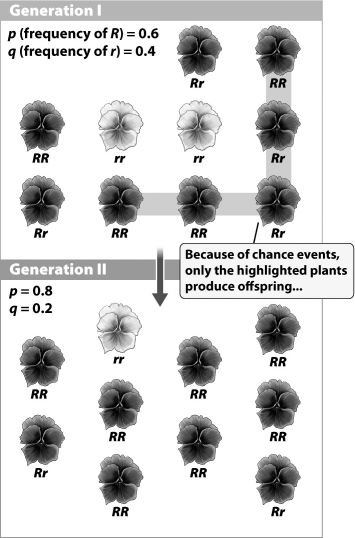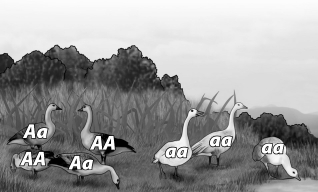A) Mutations occur in response to environmental pressures.
B) Mutations are more common in slowly growing organisms.
C) Mutations appear without regard to environmental pressures.
D) Several mutations must occur at one time for a new phenotype to appear.
Correct Answer

verified
Correct Answer
verified
Multiple Choice
In natural selection, _____ that increase survival and reproductive success become more common in a population.
A) genotypes
B) allele frequencies
C) bottlenecks
D) phenotypes
Correct Answer

verified
Correct Answer
verified
Short Answer
The shape of the graph below indicates that birth weight is an example of ____________________ selection.

Correct Answer

verified
Correct Answer
verified
Multiple Choice
According to the figure below, the r allele is less frequent in generation II of this flower population. The frequency of r decreases in this population because 
A) of genetic drift.
B) recessive alleles are always less common than dominant alleles.
C) p + q must always equal 1.
D) R alleles are more likely to "hide" r alleles in generation II.
Correct Answer

verified
Correct Answer
verified
Short Answer
____________________ are the original source of genetic variation within a population.
Correct Answer

verified
Mutations
Correct Answer
verified
Multiple Choice
The geese shown in the figure below are all members of the same population. What is the genotype frequency of AA? 
A) 0.29
B) 0.57
C) 0.71
D) 0.43
Correct Answer

verified
Correct Answer
verified
Multiple Choice
What is genetic drift?
A) gene mutation within, or between, populations
B) chance evolutionary change occurring in small populations
C) natural selection acting on large populations
D) shifts in allelic frequencies due to mutation
Correct Answer

verified
Correct Answer
verified
Multiple Choice
A population of 8,250 mice occupies the sand dunes in a coastal area. A severe hurricane washes out several miles of sand dunes. As a result, only 50 mice remain. The population has experienced
A) horizontal gene transfer.
B) gene flow.
C) founder effect.
D) a bottleneck.
Correct Answer

verified
Correct Answer
verified
Multiple Choice
Gene flow between two populations
A) makes the genetic composition of the two populations more similar.
B) eliminates harmful alleles.
C) magnifies the effects of genetic drift.
D) creates genetic differences between the populations.
Correct Answer

verified
Correct Answer
verified
True/False
The Amish people began as a colony of just 200 settlers in America. The fact that Ellis-van Creveld syndrome, a genetic disorder also known as six-fingered dwarfism, is more common among the Amish than other human populations is probably a result of founder effect.
Correct Answer

verified
Correct Answer
verified
Multiple Choice
The human allele that causes six fingers per hand is dominant over the allele that produces five fingers per hand, yet most humans have five fingers per hand. Why is this so?
A) A Punnett square shows this situation to be impossible.
B) The F2 generation never expresses the dominant trait.
C) The heterozygote expresses the recessive trait.
D) The six-finger allele exists at a low frequency in the human population.
Correct Answer

verified
Correct Answer
verified
Multiple Choice
The frequency of the genotype aa in a population is 0.09. What is the frequency of the allele a in the population?
A) 0.7
B) 0.81
C) 0.3
D) 0.0081
Correct Answer

verified
Correct Answer
verified
True/False
In fish undergoing sexual selection, females are more likely to mate with males lacking coloration because brightly colored males are more visible to predators.
Correct Answer

verified
Correct Answer
verified
Multiple Choice
In your backyard, you step on a dandelion and one of its seeds gets trapped in the tread of your shoes. The next day, you go on a long hike in the wilderness wearing the same shoes. When you step in a mud puddle, the seed sticks in the mud. The seed grows into a dandelion, but no other dandelions are present to mate with it. This is an example of
A) gene flow.
B) genetic drift.
C) natural selection.
D) sexual selection.
Correct Answer

verified
Correct Answer
verified
Multiple Choice
Which of the following is not a cause of evolution?
A) mutation
B) gene flow
C) stable environmental conditions
D) sexual selection
Correct Answer

verified
C
Correct Answer
verified
Multiple Choice
While on a camping trip, you collect a white tadpole from a pond and take it home. The tadpole develops into a white bullfrog. When the frog gets too big, you release it into a local pond. The next year, several white bullfrogs are observed in the pond. This is an example of
A) genetic drift.
B) natural selection.
C) gene flow.
D) sexual selection.
Correct Answer

verified
Correct Answer
verified
Multiple Choice
How do natural selection and sexual selection differ?
A) Natural selection increases the frequency of alleles that contribute to survival, but sexual selection may increase the frequency of alleles that are not beneficial to survival.
B) Natural selection contributes to genetic drift, but sexual selection contributes to gene flow.
C) Natural selection is more random than sexual selection.
D) Natural selection increases the fitness of an allele, but sexual selection increases the dimorphism of an allele.
Correct Answer

verified
Correct Answer
verified
True/False
The Hardy-Weinberg equation can be used to determine the genotype frequencies of a population that is not evolving.
Correct Answer

verified
True
Correct Answer
verified
Multiple Choice
Which of the following is not a mode of natural selection?
A) directional selection
B) disruptive selection
C) dormant selection
D) stabilizing selection
Correct Answer

verified
Correct Answer
verified
True/False
The four mechanisms that cause microevolution include gene flow, genetic drift, natural selection, and directional selection.
Correct Answer

verified
Correct Answer
verified
Showing 1 - 20 of 80
Related Exams